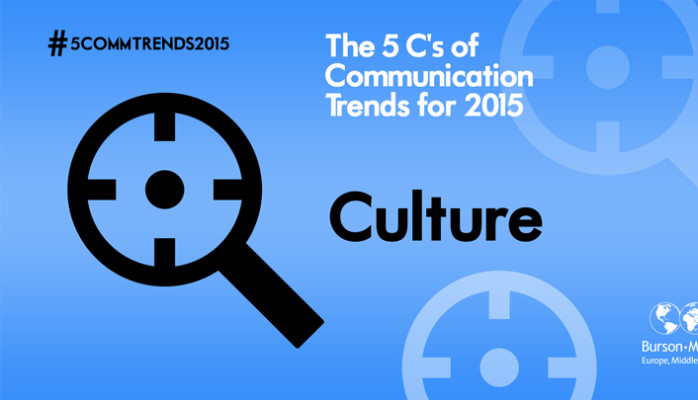
#5COMMTRENDS2015 Culture
Culture
Throughout the year, I have been blogging and tweeting about the 5 Cs of Communication Trends for 2015.
So far I’ve looked at #consumers, #connectivity and #crisis.
Culture, in corporate terms, is all about Corporate Purpose, authenticity, transparency, trust and leadership.
In today’s world consumers have a lot more insight into all of these elements due to an ever more connected world. And consumers expect companies to deliver more than good products/services and shareholder value.
Modern day crises, where companies have failed to keep faith with their Purpose or have behaved unethically, are even more quickly exposed than ever before due to the power of social media - with video being a highly effective channel of choice.
Keeping it real
In Burson-Marsteller’s most recent Purpose study Keeping It Real: How authentic is your Corporate Purpose? in partnership with the IMD Business School, we decided to delve deeper into the fundamental characteristics of what makes a Corporate Purpose authentic. The report highlighted the 12 drivers of an authentic Corporate Purpose, and further split the drivers into two broader categories; identity and image.
When these two are aligned, a truly authentic Purpose is created.
This alignment between a company’s central values and internal decision-making must be replicated in the internal culture they live and external image they project.
Otherwise, as we saw with the Volkswagen emission testing scandal a fake or inauthentic Purpose can be more damaging that not having one at all.
The Power of Purpose
The huge amount of mistrust that consumers have for corporations means that it has become even more important for businesses to illustrate that they have a Purpose beyond making a profit. Having a strong Corporate Purpose is already proven to increase an organisation's resilience during times of crisis but it goes much further than that, providing not only an improvement in financial performance but also a significant competitive advantage.
A company has to demonstrate that its Purpose is not just a marketing tool but the fundamental guide to every business decision.
An excellent example of this is Johnson & Johnson, who when making business decisions is guided by its credo, which is a 300 word statement, used as a moral compass, to ensure that every decision it makes aligns with its core principles and fulfils its obligations to its stakeholders. Johnson & Johnson has had its challenges in recent years but its reliance on its credo to inform its action has meant it retains its position as one of the most admired companies in the world.
As I frequently say, a Corporate Purpose is not a communications tool but must be lived and breathed by every single member of the organisation. If your own employees don’t believe it then why should your customers?
Nowhere to hide
Transparency around behaviour is now more important than ever with the abundance of information available at our fingertips and the rise in the power of consumers, such as Gen Z. With 8 out of 9 consumers saying that transparency is “extremely important or very important” for companies to address.
McDonald's has understood this need very well and addressed it with “Our food. Your questions”. The campaign asked consumers to submit their questions concerning McDonald´s food products on a public portal. McDonalds then published their answers to these questions, with full transparency.
This example of openness is something that has been echoed by many companies across the world. As one of the drivers of our Keeping it real study, transparency is about being truthful and honest, not only about a company's strengths, but also its weaknesses. This is something that this campaign allowed McDonald's to communicate very well.
Another important aspect of transparency is that Millennials, who will make up 75% of the global workforce by 2025, will choose to work for businesses that are open and transparent about their business activity, which provides yet another incentive for companies to pay attention to this.
Trust and Leadership
Together a strong Corporate Purpose and high degree of transparency will begin to increase the level of trust consumers have for your business. But often the role leadership plays in establishing the authenticity of a firm’s Corporate Purpose is vital, personifying both a company’s identity and image.
PepsiCo Chairman and CEO and the brains behind their Performance with Purpose initiative, Indra Nooyi, famously said that ‘we should not forget that at the end of the day, you are a person, a mother, a wife and a daughter’. Always remember who are you communicating with; trust is not just built upon the perceptions of your clients or consumers, but also your employees.
RECOMMENDATION: USE THE AUTHENTIC CORPORATE PURPOSE DIAGNOSTIC TOOL
Burson-Marsteller has put together a tool to help business leaders explore each dimension of authenticity in a comprehensive and intuitive way. We can help companies discover, define and deliver an authentic Corporate Purpose.
#1 have an authentic Corporate Purpose: authenticity is achieved when business decisions are taken based on Purpose and when your external perception and internal perception align
#2 awareness is critical
#3 leadership plays a big role
Watch out for the final of my #5COMMTRENDS2015 blogs on #Creativity appearing before the end of December.
Meanwhile I look forward to hearing your views on these and any other trends you are seeing via twitter using hashtag #5COMMTRENDS2015 @GalbraithJeremy.
For those looking for communications and other trends insights, please contact Elaine Cameron, Head of Future Perspective Trend Analysis Group, Burson-Marsteller EMEA @elaine.cameron@bm.com @FUTUREPersp




Vice President Earth Observation Sales at Kongsberg Satellite Services
8yA very insightful piece. The fact that inauthenticity has few places left to hide in the age of social media and the 24/7 news cycle is a blessing.